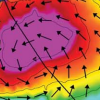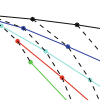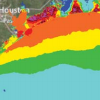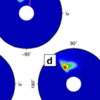
Hurricane Ike (2008) made landfall near Galveston, Texas, as a moderate intensity storm. Its large wind field in conjunction with the Louisiana-Texas coastline’s broad shelf and large scale concave geometry generated waves and surge that impacted over 1000 km of coastline. Ike’s complex and varied wave and surge response physics included: the capture of surge by the protruding Mississippi River Delta; the strong influence of wave radiation stress gradients on the Delta adjacent to the shelf break; the development of strong wind driven shore-parallel currents and the associated geostrophic setup; the forced early rise of water in coastal bays and lakes facilitating inland surge penetration; the propagation of a free wave along the southern Texas shelf; shore-normal peak wind-driven surge; and resonant and reflected long waves across a wide continental shelf. Preexisting and rapidly deployed instrumentation provided the most comprehensive hurricane response data of any previous hurricane. More than 94 wave parameter time histories, 523 water level time histories, and 206 high water marks were collected throughout the Gulf in deep water, along the nearshore, and up to 65 km inland. Ike’s highly varied physics were simulated using SWAN+ADCIRC, a tightly coupled wave and circulation model, on SL18TX33, a new unstructured mesh of the Gulf of Mexico, Caribbean Sea, and western Atlantic Ocean with high resolution of the Gulf’s coastal floodplain from Alabama to the Texas-Mexico border. A comprehensive validation was made of the model’s ability to capture the varied physics in the system.
ME Hope, JJ Westerink, AB Kennedy, PC Kerr, JC Dietrich, CN Dawson, CJ Bender, JM Smith, RE Jensen, M Zijlema, LH Holthuijsen, RA Luettich Jr, MD Powell, VJ Cardone, AT Cox, H Pourtaheri, HJ Roberts, JH Atkinson, S Tanaka, HJ Westerink, LG Westerink (2013). “Hindcast and Validation of Hurricane Ike (2008) Waves, Forerunner,
and Storm Surge.” Journal of Geophysical Research: Oceans, 118, 4424-4460, DOI: 10.1002/jgrc.20314.
 Hurricane Sandy devastated the Northeast US coastline in 2012. In New York City, it caused power outages that affected nearly 2 million people, forced evacuations of 6500 patients from hospitals and nursing homes, prevented 1.1 million children from attending school for a week, and disrupted the daily travel of about 11 million commuters. Many of these impacts were related to flooding of critical infrastructure, including nearly 90,000 buildings, and more than $5 billion in damages in the mass transit system. The maximum observed water level at the tidal gauge located at the southern tip of Manhattan was 5.3 m above the station datum and 2.8 m above the expected tide. This additional water, known as storm surge, was pushed from the open sea by strong winds during the storm. Sandy was one of several recent storms to cause flooding along the US Gulf and Atlantic coasts, including Katrina and Rita (2005), Gustav and Ike (2008), Irene (2011), Isaac (2012), and Hermine and Matthew (2016). Climatic changes are causing these storms to be larger and more intense, last longer, and move farther northward. Their impacts will be more severe to communities in coastal regions in the future.
Hurricane Sandy devastated the Northeast US coastline in 2012. In New York City, it caused power outages that affected nearly 2 million people, forced evacuations of 6500 patients from hospitals and nursing homes, prevented 1.1 million children from attending school for a week, and disrupted the daily travel of about 11 million commuters. Many of these impacts were related to flooding of critical infrastructure, including nearly 90,000 buildings, and more than $5 billion in damages in the mass transit system. The maximum observed water level at the tidal gauge located at the southern tip of Manhattan was 5.3 m above the station datum and 2.8 m above the expected tide. This additional water, known as storm surge, was pushed from the open sea by strong winds during the storm. Sandy was one of several recent storms to cause flooding along the US Gulf and Atlantic coasts, including Katrina and Rita (2005), Gustav and Ike (2008), Irene (2011), Isaac (2012), and Hermine and Matthew (2016). Climatic changes are causing these storms to be larger and more intense, last longer, and move farther northward. Their impacts will be more severe to communities in coastal regions in the future.
 Hurricane Sandy devastated the Northeast US coastline in 2012. In New York City, it caused power outages that affected nearly 2 million people, forced evacuations of 6500 patients from hospitals and nursing homes, prevented 1.1 million children from attending school for a week, and disrupted the daily travel of about 11 million commuters. Many of these impacts were related to flooding of critical infrastructure, including nearly 90,000 buildings, and more than $5 billion in damages in the mass transit system. The maximum observed water level at the tidal gauge located at the southern tip of Manhattan was 5.3 m above the station datum and 2.8 m above the expected tide. This additional water, known as storm surge, was pushed from the open sea by strong winds during the storm. Sandy was one of several recent storms to cause flooding along the US Gulf and Atlantic coasts, including Katrina and Rita (2005), Gustav and Ike (2008), Irene (2011), Isaac (2012), and Hermine and Matthew (2016). Climatic changes are causing these storms to be larger and more intense, last longer, and move farther northward. Their impacts will be more severe to communities in coastal regions in the future.
Hurricane Sandy devastated the Northeast US coastline in 2012. In New York City, it caused power outages that affected nearly 2 million people, forced evacuations of 6500 patients from hospitals and nursing homes, prevented 1.1 million children from attending school for a week, and disrupted the daily travel of about 11 million commuters. Many of these impacts were related to flooding of critical infrastructure, including nearly 90,000 buildings, and more than $5 billion in damages in the mass transit system. The maximum observed water level at the tidal gauge located at the southern tip of Manhattan was 5.3 m above the station datum and 2.8 m above the expected tide. This additional water, known as storm surge, was pushed from the open sea by strong winds during the storm. Sandy was one of several recent storms to cause flooding along the US Gulf and Atlantic coasts, including Katrina and Rita (2005), Gustav and Ike (2008), Irene (2011), Isaac (2012), and Hermine and Matthew (2016). Climatic changes are causing these storms to be larger and more intense, last longer, and move farther northward. Their impacts will be more severe to communities in coastal regions in the future.


 Rising sea level represents a significant threat to coastal communities and ecosystems, including altered habitats and increased vulnerability to coastal storms and recurrent inundation. This threat is exemplified in the northern Gulf of Mexico, where low topography, marshes, and a prevalence of tropical storms have resulted in extensive coastal impacts. The ability to facilitate adaptation and mitigation measures relies, in part, on the development of robust predictive capabilities that incorporate complex biological processes with physical dynamics. Initiated in 2010, the 6-year Ecological Effects of Sea Level Rise—Northern Gulf of Mexico project applied a transdisciplinary science approach to develop a suite of integrated modeling platforms informed by empirical data that are capable of evaluating a range of climate change scenarios. This special issue highlights resultant integrated models focused on tidal hydrodynamics, shoreline morphology, oyster ecology, coastal wetland vulnerability, and storm surges that demonstrate the need for dynamic models to incorporate feedbacks among physical and biological processes in assessments of sea level rise effects on coastal systems. Effects are projected to be significant, spatially variable and nonlinear relative to sea level rise rates. Scenarios of higher sea level rise rates are projected to exceed thresholds of wetland sustainability, and many regions will experience enhanced storm surges. Influenced by an extensive collaborative stakeholder engagement process, these assessments on the coastal dynamics of sea level rise provide a strong foundation for resilience measures in the northern Gulf of Mexico and a transferable approach for application to other coastal regions throughout the world.
Rising sea level represents a significant threat to coastal communities and ecosystems, including altered habitats and increased vulnerability to coastal storms and recurrent inundation. This threat is exemplified in the northern Gulf of Mexico, where low topography, marshes, and a prevalence of tropical storms have resulted in extensive coastal impacts. The ability to facilitate adaptation and mitigation measures relies, in part, on the development of robust predictive capabilities that incorporate complex biological processes with physical dynamics. Initiated in 2010, the 6-year Ecological Effects of Sea Level Rise—Northern Gulf of Mexico project applied a transdisciplinary science approach to develop a suite of integrated modeling platforms informed by empirical data that are capable of evaluating a range of climate change scenarios. This special issue highlights resultant integrated models focused on tidal hydrodynamics, shoreline morphology, oyster ecology, coastal wetland vulnerability, and storm surges that demonstrate the need for dynamic models to incorporate feedbacks among physical and biological processes in assessments of sea level rise effects on coastal systems. Effects are projected to be significant, spatially variable and nonlinear relative to sea level rise rates. Scenarios of higher sea level rise rates are projected to exceed thresholds of wetland sustainability, and many regions will experience enhanced storm surges. Influenced by an extensive collaborative stakeholder engagement process, these assessments on the coastal dynamics of sea level rise provide a strong foundation for resilience measures in the northern Gulf of Mexico and a transferable approach for application to other coastal regions throughout the world.
 The SWAN+ADCIRC shallow-water circulation model, validated for Hurricane Ike (2008), was used to develop five synthetic storm surge scenarios for the upper Texas coast in which wind speed was increased and landfall location was shifted 40 km westward. The Hurricane Ike simulation and the synthetic storms were used to study the maximum water elevations in Galveston Bay, as well as the timing and behavior of surge relative to the hurricane track. Sixteen locations indicative of surge behavior in and around Galveston Bay were chosen for analysis in this paper. Results show that water surface elevations present in Galveston Bay are dominated by the counterclockwise hurricane winds and that increasing wind speeds by 15% results in approximately 23% (+/−3%) higher surge. Furthermore, shifting the storm westward causes higher levels of surge in the more populated areas due to more intense, higher shore-normal winds. This research helps to highlight the vulnerability of the upper Texas Gulf Coast to hurricane storm surge and lends insight to storm surge and flood mitigation studies in the Houston–Galveston region.
The SWAN+ADCIRC shallow-water circulation model, validated for Hurricane Ike (2008), was used to develop five synthetic storm surge scenarios for the upper Texas coast in which wind speed was increased and landfall location was shifted 40 km westward. The Hurricane Ike simulation and the synthetic storms were used to study the maximum water elevations in Galveston Bay, as well as the timing and behavior of surge relative to the hurricane track. Sixteen locations indicative of surge behavior in and around Galveston Bay were chosen for analysis in this paper. Results show that water surface elevations present in Galveston Bay are dominated by the counterclockwise hurricane winds and that increasing wind speeds by 15% results in approximately 23% (+/−3%) higher surge. Furthermore, shifting the storm westward causes higher levels of surge in the more populated areas due to more intense, higher shore-normal winds. This research helps to highlight the vulnerability of the upper Texas Gulf Coast to hurricane storm surge and lends insight to storm surge and flood mitigation studies in the Houston–Galveston region.
 On large geographic scales, ocean waves are represented in a spectral sense via the action balance equation, which propagates action density through both geographic and spectral space. In this paper, a new computational spectral wave model is developed by using discontinuous Galerkin (DG) methods in both geographic and spectral space. DG methods allow for the use of unstructured geographic meshes and higher-order approximations for action propagation in both geographic and spectral space, which we show leads to increased accuracy. This DG spectral wave propagation model is verified and validated through comparisons to manufactured and analytic solutions as well as to the Simulating WAves Nearshore (SWAN) model. Coupled wave/circulation models are needed for many applications including for the interaction between waves and currents during daily wind and tide driven flows. We loosely couple the newDGspectralwavemodel to the DG Shallow Water Equation Model (DG-SWEM), an existing DG circulation model. In addition to formulating the DG method for the coupled wave/circulation model, we derive an a priori error estimate. Preliminary numerical results of the DG coupled wave/circulation model are presented with comparisons to DG-SWEM coupled tightly to SWAN.
On large geographic scales, ocean waves are represented in a spectral sense via the action balance equation, which propagates action density through both geographic and spectral space. In this paper, a new computational spectral wave model is developed by using discontinuous Galerkin (DG) methods in both geographic and spectral space. DG methods allow for the use of unstructured geographic meshes and higher-order approximations for action propagation in both geographic and spectral space, which we show leads to increased accuracy. This DG spectral wave propagation model is verified and validated through comparisons to manufactured and analytic solutions as well as to the Simulating WAves Nearshore (SWAN) model. Coupled wave/circulation models are needed for many applications including for the interaction between waves and currents during daily wind and tide driven flows. We loosely couple the newDGspectralwavemodel to the DG Shallow Water Equation Model (DG-SWEM), an existing DG circulation model. In addition to formulating the DG method for the coupled wave/circulation model, we derive an a priori error estimate. Preliminary numerical results of the DG coupled wave/circulation model are presented with comparisons to DG-SWEM coupled tightly to SWAN.
 This paper investigates model response sensitivities to mesh resolution, topographical details, bottom friction formulations, the interaction of wind waves and circulation, and nonlinear advection on tidal and hurricane surge and wave processes at the basin, shelf, wetland, and coastal channel scales within the Gulf of Mexico. Tides in the Gulf of Mexico are modestly energetic processes, whereas hurricane surge and waves are highly energetic. The unstructured-mesh, coupled wind-wave and circulation modeling system, SWAN+ADCIRC, is implemented to generate modeled tidal harmonic constituents and hurricane waves and surge for a Hurricane Ike (2008) hindcast. In the open ocean, mesh resolution requirements are less stringent in achieving accurate tidal signals or matching hurricane surge and wave responses; however, coarser resolution or the absence of intertidal zones decreases accuracy along protected nearshore and inland coastal areas due to improper conveyance and/or lateral attenuation. Bottom friction formulations are shown to have little impact on tidal signal accuracy, but hurricane surge is much more sensitive, especially in shelf waters, where development of a strong shore-parallel current is essential to the development of Ike’s geostrophic setup. The spatial and temporal contributions of wave radiation stress gradients and nonlinear advection were charted for Ike. Nonlinear advection improves model performance by capturing an additional 10–20 cm of geostrophic setup and increasing resonant cross-shelf waves by 30–40 cm. Wave radiation stress gradients improve performance at coastal stations by adding an extra 20–40 cm to water levels.
This paper investigates model response sensitivities to mesh resolution, topographical details, bottom friction formulations, the interaction of wind waves and circulation, and nonlinear advection on tidal and hurricane surge and wave processes at the basin, shelf, wetland, and coastal channel scales within the Gulf of Mexico. Tides in the Gulf of Mexico are modestly energetic processes, whereas hurricane surge and waves are highly energetic. The unstructured-mesh, coupled wind-wave and circulation modeling system, SWAN+ADCIRC, is implemented to generate modeled tidal harmonic constituents and hurricane waves and surge for a Hurricane Ike (2008) hindcast. In the open ocean, mesh resolution requirements are less stringent in achieving accurate tidal signals or matching hurricane surge and wave responses; however, coarser resolution or the absence of intertidal zones decreases accuracy along protected nearshore and inland coastal areas due to improper conveyance and/or lateral attenuation. Bottom friction formulations are shown to have little impact on tidal signal accuracy, but hurricane surge is much more sensitive, especially in shelf waters, where development of a strong shore-parallel current is essential to the development of Ike’s geostrophic setup. The spatial and temporal contributions of wave radiation stress gradients and nonlinear advection were charted for Ike. Nonlinear advection improves model performance by capturing an additional 10–20 cm of geostrophic setup and increasing resonant cross-shelf waves by 30–40 cm. Wave radiation stress gradients improve performance at coastal stations by adding an extra 20–40 cm to water levels.
 Hurricane Ike (2008) made landfall near Galveston, Texas, as a moderate intensity storm. Its large wind field in conjunction with the Louisiana-Texas coastline’s broad shelf and large scale concave geometry generated waves and surge that impacted over 1000 km of coastline. Ike’s complex and varied wave and surge response physics included: the capture of surge by the protruding Mississippi River Delta; the strong influence of wave radiation stress gradients on the Delta adjacent to the shelf break; the development of strong wind driven shore-parallel currents and the associated geostrophic setup; the forced early rise of water in coastal bays and lakes facilitating inland surge penetration; the propagation of a free wave along the southern Texas shelf; shore-normal peak wind-driven surge; and resonant and reflected long waves across a wide continental shelf. Preexisting and rapidly deployed instrumentation provided the most comprehensive hurricane response data of any previous hurricane. More than 94 wave parameter time histories, 523 water level time histories, and 206 high water marks were collected throughout the Gulf in deep water, along the nearshore, and up to 65 km inland. Ike’s highly varied physics were simulated using SWAN+ADCIRC, a tightly coupled wave and circulation model, on SL18TX33, a new unstructured mesh of the Gulf of Mexico, Caribbean Sea, and western Atlantic Ocean with high resolution of the Gulf’s coastal floodplain from Alabama to the Texas-Mexico border. A comprehensive validation was made of the model’s ability to capture the varied physics in the system.
Hurricane Ike (2008) made landfall near Galveston, Texas, as a moderate intensity storm. Its large wind field in conjunction with the Louisiana-Texas coastline’s broad shelf and large scale concave geometry generated waves and surge that impacted over 1000 km of coastline. Ike’s complex and varied wave and surge response physics included: the capture of surge by the protruding Mississippi River Delta; the strong influence of wave radiation stress gradients on the Delta adjacent to the shelf break; the development of strong wind driven shore-parallel currents and the associated geostrophic setup; the forced early rise of water in coastal bays and lakes facilitating inland surge penetration; the propagation of a free wave along the southern Texas shelf; shore-normal peak wind-driven surge; and resonant and reflected long waves across a wide continental shelf. Preexisting and rapidly deployed instrumentation provided the most comprehensive hurricane response data of any previous hurricane. More than 94 wave parameter time histories, 523 water level time histories, and 206 high water marks were collected throughout the Gulf in deep water, along the nearshore, and up to 65 km inland. Ike’s highly varied physics were simulated using SWAN+ADCIRC, a tightly coupled wave and circulation model, on SL18TX33, a new unstructured mesh of the Gulf of Mexico, Caribbean Sea, and western Atlantic Ocean with high resolution of the Gulf’s coastal floodplain from Alabama to the Texas-Mexico border. A comprehensive validation was made of the model’s ability to capture the varied physics in the system.
 Storm surge due to hurricanes and tropical storms can result in significant loss of life, property damage, and long-term damage to coastal ecosystems and landscapes. Computer modeling of storm surge is useful for two primary purposes: forecasting of storm impacts for response planning, particularly the evacuation of vulnerable coastal populations; and hindcasting of storms for determining risk, development of mitigation strategies, coastal restoration, and sustainability. Model results must be communicated quickly and effectively, to provide context about the magnitudes and locations of the maximum waves and surges in time for meaningful actions to be taken in the impact region before a storm strikes.
Storm surge due to hurricanes and tropical storms can result in significant loss of life, property damage, and long-term damage to coastal ecosystems and landscapes. Computer modeling of storm surge is useful for two primary purposes: forecasting of storm impacts for response planning, particularly the evacuation of vulnerable coastal populations; and hindcasting of storms for determining risk, development of mitigation strategies, coastal restoration, and sustainability. Model results must be communicated quickly and effectively, to provide context about the magnitudes and locations of the maximum waves and surges in time for meaningful actions to be taken in the impact region before a storm strikes.
 As phase-averaged spectral wave models continue to grow in sophistication, they are applied more frequently throughout the ocean, from the generation of waves in deep water to their dissipation in the nearshore. Mesh spacings are varied within the computational domain, either through the use of nested, structured meshes or a single, unstructured mesh. This approach is economical, but it can cause accuracy errors in regions where the input parameters are under-resolved. For instance, in regions with a coarse representation of bathymetry, refraction can focus excessive wave energy at a single mesh vertex, causing the computed solution to become non-physical. Limiters based on the Courant–Friedrichs–Lewy (CFL) criteria are proposed for the spectral propagation (refraction and frequency shifting) velocities in SWAN. These limiters are not required for model stability, but they improve accuracy by reducing local errors that would otherwise spread throughout the computational domain. As demonstrated on test cases in deep and shallow water, these limiters prevent the excessive directional turning and frequency shifting of wave energy and control the largest errors in under-resolved regions.
As phase-averaged spectral wave models continue to grow in sophistication, they are applied more frequently throughout the ocean, from the generation of waves in deep water to their dissipation in the nearshore. Mesh spacings are varied within the computational domain, either through the use of nested, structured meshes or a single, unstructured mesh. This approach is economical, but it can cause accuracy errors in regions where the input parameters are under-resolved. For instance, in regions with a coarse representation of bathymetry, refraction can focus excessive wave energy at a single mesh vertex, causing the computed solution to become non-physical. Limiters based on the Courant–Friedrichs–Lewy (CFL) criteria are proposed for the spectral propagation (refraction and frequency shifting) velocities in SWAN. These limiters are not required for model stability, but they improve accuracy by reducing local errors that would otherwise spread throughout the computational domain. As demonstrated on test cases in deep and shallow water, these limiters prevent the excessive directional turning and frequency shifting of wave energy and control the largest errors in under-resolved regions.